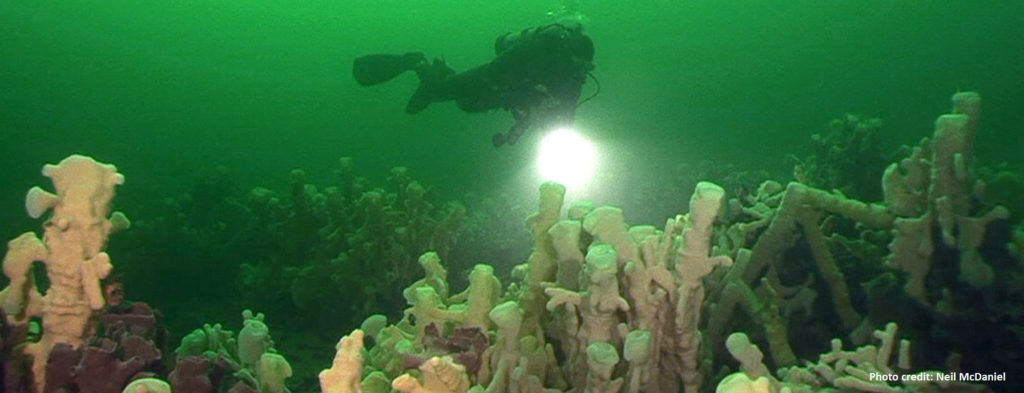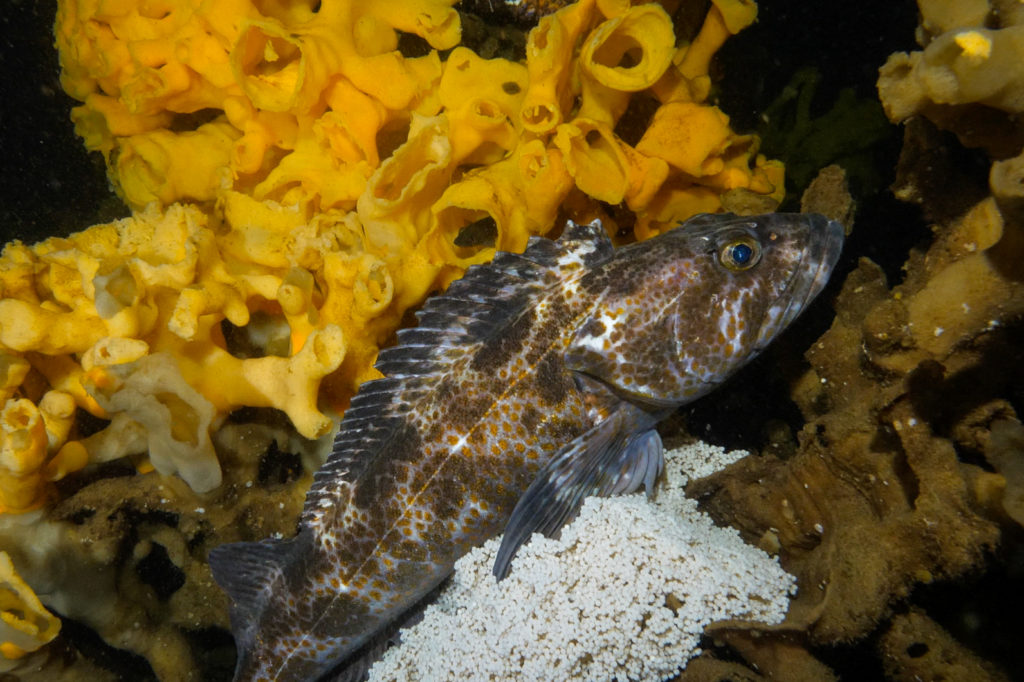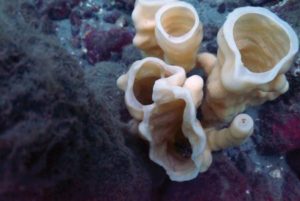How sound are the protections for Howe Sound’s glass sponge reefs?
By Sonia Singh Jind, 25 January 2019

When scientists stumbled upon an assembly of strange, blanched formations growing overtop of one another and stretching out for hundreds of kilometers across the seafloor, they had no idea they were looking at living glass sponge reefs.
Until then, these reefs were thought to have been extinct since the Jurassic, which ended over 200 million years ago. Scientists are not quite sure why glass sponge reefs seem to have only survived off the west coast of BC, but the answers may give us insight into why these ghostly reef-builders are so rare.
Individual glass sponges – simple animals that use silica (or glass) to build their skeleton – are found in several locations throughout the world, such as the west coast of the United States and Antarctica. However, glass sponge reefs are extremely rare, and seem to only occur in certain environmental conditions. These complex structures form when individual glass sponges grow on top of one another, eventually forming towering structures that can reach up to 20m high.

The most extensive glass sponge reefs have been found in Hecate Strait, where they cover hundreds of kilometers of sea floor. Smaller reefs have since been discovered in the Strait of Georgia, Chatham Sound, and the Broughton Archipelago, with 14 of those in Howe Sound. It appears that the unusually high silica and oxygen in the water, an optimal level of water flow, food supply, and temperature, make the coast of BC and Alaska the only known coastline to support glass sponge reefs in the entire world.
The foundation of ocean ecosystems
Glass sponge reefs aren’t just pretty to look at, they are also ecologically important in a variety of ways. The 3D structures these reefs provide on an otherwise almost barren seafloor create habitat and areas of refuge for seastars, prawns, lobster, and a variety of fish, including halibut, cod, herring, and the threatened rockfish.
Sponges have the amazing ability to filter 95% of bacteria in the water. You can think of a field of glass sponges as the ocean’s natural filtration system, filtering huge amounts of ocean water every second and producing ammonia that other organisms need for life processes, thereby supporting ecosystem health.
Just as their name suggests, these sponges are fragile. Their texture is similar to meringue, so they break easily. Despite their fragility, they can live thousands of years: some reefs on BC’s coast have been aged at 9,000 years old. They likely survived, in part, because they live so far from the surface of the ocean and away from human contact. But recently humans have begun to exploit the ocean at depths which were previously unreachable, and the threats to this fragile species have intensified.
Human activities such as bottom-trawl fishing and down-rigging can easily destroy these ancient 9,000 year old reefs in seconds. Prawn and crab traps hitting the bottom, the laying of submarine cables and damage from anchors can all cause physical damage and stir up sediment in the water, smothering the sponges. Sponges stop feeding when covered in sediment, eventually leading to starvation and death. Glass sponges take over 200 years to grow just 1 metre in height, so when they are damaged, they could take hundreds of years to recover, if ever.
Protecting glass sponge reefs

CPAWS-BC has been working on glass sponge reef protection for over 25 years, drawing global attention, educating the public, and urging the government to protect these sites of international importance. In 2002 Oceans and Fisheries Canada (DFO) created fishing closures prohibiting bottom-trawling over the glass sponge reefs. But this was not enough. The reefs needed permanent protection. It took another 8 years before DFO announced Hecate Strait (the site where the reefs were first discovered in 1987) as an Area of Interest under consideration to become a Marine Protected Area (MPA).
Finally, in 2017, after a strong push for higher protection standards, CPAWS-BC rejoiced as the Hecate Strait & Queen Charlotte Sound Glass Sponge Reefs MPA was established. The reefs in Hecate Strait are currently protected within 150m around them.
While this MPA and the preceding fishing closures over the Strait of Georgia reefs were major wins towards protecting our glass sponge reefs, there are over 20 glass sponge reefs in Howe Sound, Chatham Sound and the Broughton Archipelago that still need protection.
CPAWS-BC is currently leading the charge to ensure the ancient reef-building animals in Howe Sound are protected from bottom-contact fishing and undersea pipelines, both of which pose an immediate threat to their survival.
To learn more about glass sponge reefs and how you can protect them, check out https://cpawsbc.org/glass-sponge-reefs/
